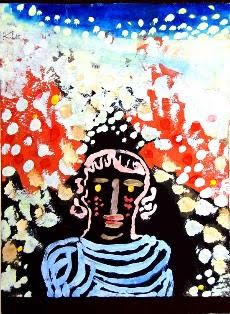The images below are some of my favorites from the Bauhaus: Workshops for Modernity exhibition at MoMA on view through Jan 25, 2010.
 Joseph Albers of left: Glass in Grid, Upward, Skyscraper on Transparent Yellow, Paul Klee on right: Angler, The Twittering Machine, Mask of Fear
Joseph Albers of left: Glass in Grid, Upward, Skyscraper on Transparent Yellow, Paul Klee on right: Angler, The Twittering Machine, Mask of FearWhile this informative exhibition will lead you through the history of the Bauhaus school from 1919 to 1933, the infighting of school leaders and teaching system didn’t interest me quite as much as work of some of those who studied or worked at the school. The work of two pupils/teachers of Bauhaus on view are shown above: Joseph Albers and Paul Klee.
Albers produced the images on the left, a series of glass grids. These jpegs can’t do justice to the quality of the glass and how it works with the color, but these are really beautiful pieces. The first is truly stunning: ends of bottles and other shards are wrapped into a grid with black wires. For a really amazing view of a similar piece, check this out. Later, Albers perfected a sandblasted method that created the sharp, flat later pieces seen below.
Klee, whose images are to the right, was a teacher at Bauhaus. These watercolors of Klee’s were partially a way for him to work out color. Color theory was a large part of the Bauhaus curriculum, and important for both artists, although it appears more clearly in Alber’s work here. What I think is fascinating about looking at the work of these two influential artists next to each other, in conjunction with the school they both taught at, is the very different work they produced. Neither artist’s work fits with the image of Bauhaus I had going into the exhibition, which especially early on espoused a surprising spirituality and never truly lost its forward-looking optimism.
Bauhaus as a style has come to mean something quite different than the competing aesthetics and theories produced at the time suggests. This thorough MoMA exhibition, comprised of hundreds of objects, suggests the vibrant life of the school, which so hopefully produced objects for the future. More about the exhibition from the New York Times here.
h
 In response to the news, the Isabella Stewart Gardner Museum in Boston is reported to have said, “It’s not fair! They aren’t even offering a reward!” The Gardner Museum retired early to bed with a case of false hope.
In response to the news, the Isabella Stewart Gardner Museum in Boston is reported to have said, “It’s not fair! They aren’t even offering a reward!” The Gardner Museum retired early to bed with a case of false hope.
